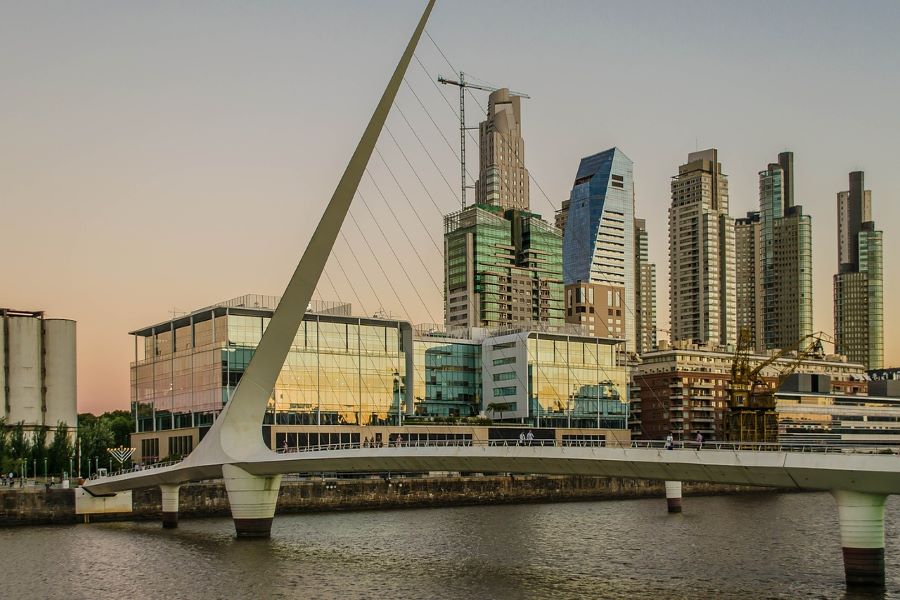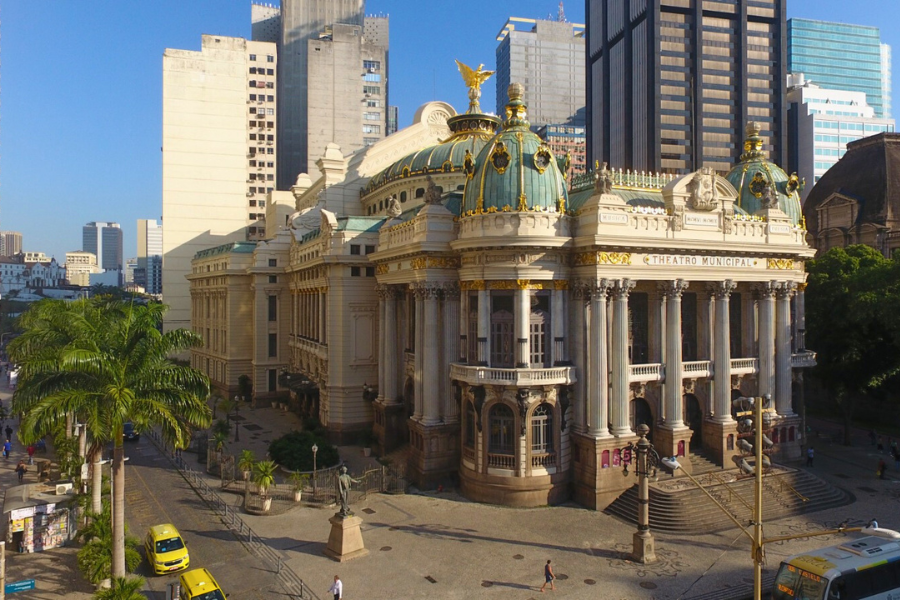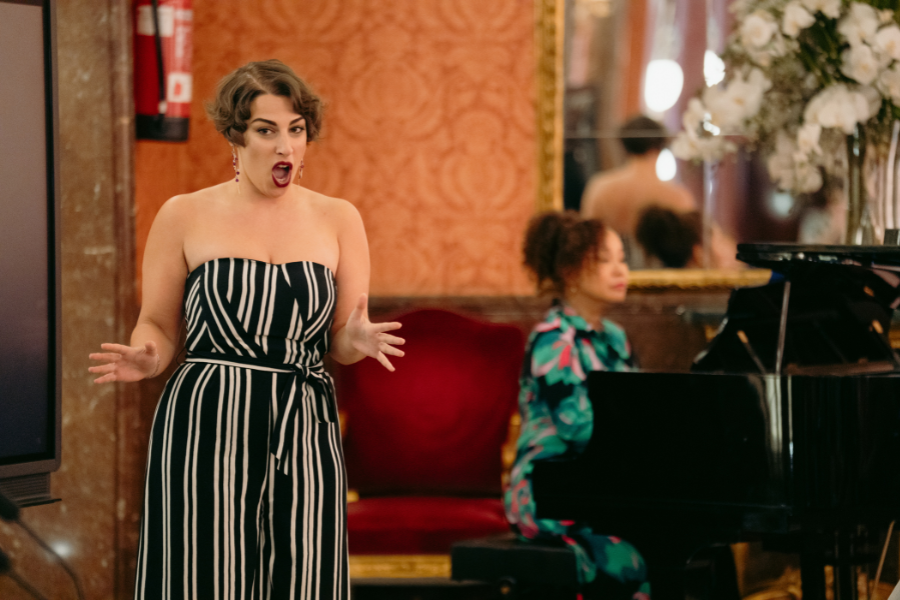Los Teatros Líricos en el interior de Argentina

por NÉSTOR ECHEVARRÍA
El tema de los teatros líricos del interior de la Argentina merece sin duda un examen y análisis singular, puesto que entroncan con el advenimiento de la ópera en nuestro medio y a la vez con conceptos de la sociedad y su crecimiento, desarrollo de la inmigración y toda una problemática que tiene que ver con gran parte de la historia nacional.
Porque a poco de la integración de la ópera al espectro cultural de la ciudad de Buenos Aires, en su fase evolutiva poscolonial, con una primera representación en 1825 de “Il barbiere di Siviglia” de Gioacchino Rossini, por la compañía de Mariano Pablo Rosquellas (tenor español que llegó al Plata con el maestro Massoni y un grupo de cantantes para ofrecer las primeras representaciones integrales en el viejo Coliseo provisional) el arte lírico fue tomando su fase afirmativa en la todavía Gran Aldea y producir su consiguiente expansión y potenciamiento.
Proceso que amalgama dos fases, la paulatina asimilación de la ópera como espectáculo y la paulatina mejora y progreso en esta tipología arquitectónica, sobre la base de modelos europeos, particularmente de influencia italiana. Este hecho se refleja claramente en la evolución de los teatros porteños pero también en la resonancia que el tema ha tenido en nuestro interior y sus principales ciudades.
Por eso en este artículo me ocuparé fundamentalmente de esos teatros de ciudades y provincias argentinas, que por supuesta tienen amplia influencia de nuestra principal ciudad y capital del país, Buenos Aires. Dejo pues para otra nota la referencia específica a la evolución de los teatros y la ópera en el ámbito capitalino.
Gran etapa expansiva
El período finisecular del siglo XIX y los comienzos del siglo XX ve entonces una extraordinaria etapa de crecimiento arquitectónico en las ciudades del interior, paralelamente a una recepción también potenciada del espectáculo de ópera, en aquel momento de la también llamada “bel époque”.
Los municipios comienzan a hacerse cargo de la construcción de Teatros a la italiana, según el modelo tipológico vigente en el viejo mundo. Y así encontramos en la ciudad de Córdoba, por ejemplo, el surgimiento del Teatro Rivera Indarte (hoy Libertador Gral San Martin) obra del arquitecto Francesco Tamburini el primer profesional interviniente en el proyecto del Colón actual de Buenos Aires casi enseguida) que generó uno de los teatros mayores e importantes del país, modelo conspicuo del academicismo italiano. Era el momento que la introducción de los modelos europeizantes impulsaban la moda arquitectónica decimonónica. Inaugurado en 1891, con ciento treinta años encima, sigue vigente y sus momentos de un largo y brillante pasado comulgan con el destino cultural de los cordobeses. Es uno de los más activos del país, hoy día.
Entre tanto, la nueva capital de la provincia de Buenos Aires, ya había entrado en acción. Con la creación del Teatro Argentino de La Plata, hoy, por su enclave institucional y actividad es considerado el segundo teatro lírico del país, luego del Colón de Buenos Aires. La ciudad de La Plata, fundada por Dardo Rocha en 1882, con el crecimiento edilicio no podía privarse de un importante teatro, ubicado en un lugar estratégico del plan urbano del francés, Pierre Benoit, y el primitivo proyecto del arquitecto italiano Leopoldo Rocchi respondía con fidelidad a su encuadre y entorno de la nueva capital, con su acentuado concepto academicista italiano, la sala “a ferro di cavallo” tan emblemática en la península y la concepción general y ornamental. Se inauguró con “Otello” de Verdi personificado por el tenor uruguayo Jose Oxilia. Y supo de temporadas valiosas.
La destrucción por el voraz incendio de 1977 dio lugar a un concurso de anteproyectos del cual surgió la nueva idea , monumentalista y también “brutalista” conforme la corriente pos-lecurbusiana de ese tiempo, del estudio platense Garcia, Germani, Rubio y otros, que con sus diversas salas, amplisimas superficies y una idea general de un octágono que se referencia a la trama de calles y diagonales típicas de la geometría platense, fueron dando la visión actual de un teatro importante y representativo del hacer provincial, a partir de su inauguración en 1999. El nuevo Teatro Argentino ya volvió al ruedo.
Pero también cabe consignar que La Plata ya había inaugurado la construcción de su primer teatro con un proyecto del uruguayo Carlos Zenhdorf cuatro años desde su fundación. El Politeama Olimpo, rebautizado después como Coliseo Podestà y hoy vigente, con su sala “alla italiana” y su tipología sencillamente planteada. hoy pertenece al municipio platense y se encuentra adecuadamente restaurado orientado a su función original de teatro de prosa.
Por provincias y ciudades
Esta verdadera invasión de teatros líricos (porque la tipología así lo distingue) aunque muchas de esas salas cumplen funciones heteróclitas, variadas, y eclécticas en sus programaciones artísticas, van surgiendo en las capitales provinciales y en ciudades importantes, como el caso de Rosario en la provincia de Santa Fe.
Muy temprano llegó la lírica al público rosarino, en las décadas finales del ochocientos y cuando la Sociedad anónima “Teatro la Ópera” decida la construcción de un importante teatro en la esquina de Laprida y Mendoza de la bautizada como “Chicago Argentina”, comienza la obra a cargo de los profesionales itálicos Cremona y Contri, para luego quedar varios años interrumpida (un fenómeno típico en la época, como también le paso al Colón porteño, por ejemplo)
Cuando la sociedad se vende y aparece nuevo comitente de las obras y se adjudican las mismas al ingeniero alemán George Goldammer, se puede llevar a cabo el objetivo. La Ópera de Rosario abrió sus puertas el 7 de junio de 1904, años de glorias, de virtuosos cantantes ( el gran Enrico Caruso, infaltable cuando su presencia en nuestro país) fueron dando brillo a la operística en Rosario en un teatro singularmente dotado, con su forma italiana y sus mil quinientos asientos, que fue rivalizando con el más modesto Colón de Rosario, inaugurado el mismo año y demolido llegada la mitad del siglo XX. Tras penoso abandono, la Ópera fue adquirida por la Asociación Cultural El Círculo, de larga tradición en la ciudad, en 1943, originando el cambio definitivo de su nombre por el de Teatro El Círculo de Rosario. Otro activo protagonista de este tiempo en materia operística en el interior del país.
Pero sin abandonar la provincia santafesina, también la capital, Santa Fe de la Veracruz no claudicó en la tarea de proveerse de un teatro propio, impulsado por el Municipio, quedando su nombre como Teatro Municipal 1º de Mayo. Con planos de Augusto Plou se inauguró el 5 de octubre de 1905 con “La Gioconda “de Ponchielli, por la compañía italiana de Antonio Marranti, que circulaba mucho por las provincias.
En el litoral : los mismos terrenos para nuevos teatros.
El caso de las provincias litoraleñas se presenta interesante porque en su evolución histórica los teatros de las ciudades capitales de Entre Ríos y Corrientes fueron edificados en base a demoler y reemplazar aún más antiguos escenarios, dañados y perjudicados por diversas razones.
El 18 de octubre de 1908 se inauguró el Teatro 3 de Febrero de Paranà, una obra también significativa para la capital entrerriana, para lo cual el intendente de entonces convocó al arquitecto suizo Lorenzo Siegrist a realizar en el lugar físico donde existiera un precedente desde 1851 mandado a construir por Justo Jose de Urquiza y cuyo estado y conservación era deficitario. Se buscaba con ello un “aggiornamento” en la materia. Y el teatro paranaense tiene una grata impronta, con una capacidad de 850 espectadores y sobre todo en el foyer hay una muestra del sesgo centroeuropeo de su autor más allá del convencionalismo de su sala.
También el caso del Teatro Juan de Vera, en Corrientes, coincide en circunstancias parecidas. Un teatro precedente reemplazado por el actual, que se inauguró el 25 de mayo –fecha siempre recurrente- del año 1913, con “Aida” y en escena con la compañía Marrante, que anduvo en un permanente peregrinar por el interior argentino, teniendo a su cargo como se viene citando actos inaugurales de resonancia en varios teatros líricos.
Cabe también citar en ambas provincias de la Mesopotamia argentina, dos teatros declarados monumentos históricos, en el caso de Entre Ríos el de Gualeguaychú cuya apertura data de 1914 y que fuera recientemente restaurado y puesto en valor, así como el antiquísimo de la localidad de Goya, en Corrientes, que se remonta a 1877 y que es una sala que pasó por varios propietarios, el último fue el italiano Santiago Solari lo adquiere en 1927 hasta que llegado la última década del siglo, a su muerte, el teatro en mano de sus sucesores para a tomar el carácter de Municipal “Solari” de la ciudad de Goya. Modesta sala de seiscientas butacas, pero sin duda de un valor patrimonial encomiable.
Otros modelos de gestión: San Nicolás y el aportes privado
Cuando los emprendimientos teatrales tuvieron que ver con fondos destinados por las intendencias en su buena mayoría, o por entidades privadas, la colaboración de los vecinos en una obra encarada por el municipio resultó un atípico modelo de gestión.
Esto ocurrió en San Nicolás de los Arroyos, con la obra del Teatro Municipal Rafael de Aguiar, inaugurado el mismo año que el Colón de Buenos Aires, 1908 pero tres meses después ya que abrió el 10 de agosto con “Manon Lescaut” de Puccini con la compañía Bernabei , que integraba la soprano Adelina Agostinelli Calificado como el “pequeño Colón” supo de una gran atención a los detalles durante su construcción por el ingeniero local Aramburu al punto de tomar vista en forma permanente de las obras del primer coliseo porteño. Materiales importados, sillas Thonet originales, todo hizo de este teatro un verdadera proeza en una San Nicolas, para entonces aún en desarrollo en densidad urbana y poblacional.
Y ya que hablamos de la provincia de Buenos Aires habrá que destacar la importancia para Bahía Blanca de su Teatro municipal, inaugurado el 9 de agosto de 1913, un proyecto de fuste para la ciudad sureña de la provincia, de excelente y muy favorecida implantación urbanística, con nobleza de estilo en el trabajo de los arquitectos Dunant y Mallet, que dieron cierta nobleza en su eclecticismo al aspecto exterior y una sala de acústica ponderable, que abrió también con “Aida” (ópera muy recurrente, como se advierte, en teatros de nuestro país, incluido el Colón) por la compañía ya mencionada de Antonio Marranti.
En la región del Noroeste y cuyana
También oficial es en el jardín de la República, Tucumán y en su capital San Miguel, el Teatro San Martín. Restaurado actualmente, su lejana data como Teatro Odeón se remonta a 1912, cuando se inauguró un 18 de mayo, adquiriendo sobre mitad del siglo el nombre del Padre de la Patria.
En tanto en Mendoza, el Independencia, inaugurado el 18 de noviembre de 1925, ya entrado en el decenio de los veinte, se convierte en principal protagonista de la actividad variada del teatro y de la música, en los últimos años, tras conveniente puesta en valor, mayormente apreciable.
No puede dejar de mencionarse el moderno Auditorio de San Juan, como un hito referencial de la música en esa provincia cuyana. Aunque no cabe conceptualizarlo como teatro lírico en su tipología específica, pero sí como un valioso testimonio de sala de conciertos, es desde 1970 un referente importante de la cultura provincial , llevando en su nombre de “Auditorio Juan Victoria” en homenaje al ingeniero de ese nombre que fuera uno de los adalides de la reconstrucción luego del voraz terremoto de 1944 que azotó a San Juan.
Y precisamente, ya que hablamos de la provincia cuyana de San Juan el 21 de octubre de 2016 se inauguró el más reciente teatro lírico del país, denominado Teatro del Bicentenario por coincidir con ese aniversario emblemático de la declaración de nuestra Independencia. Este nuevo y más reciente teatro en el análisis que aquí realizó del interior argentino, está ubicado frente al Centro Cívico de la capital puntana, y con un diseño arquitectónico actualizado, su sala al estilo tradicional de herradura, puede alojar 1.100 espectadores y posee también generosas dependencias complementarias.
La inauguración del teatro sanjuanino tuvo resonancia, pues se ofreció en forma escénica la cantata profana “Carmina Burana”, de Carl Orff, con la puesta del afamado grupo catalán “La fura dels Baus”, acompañado en lo musical con solistas, el coro de la Provincia de San Juan y la Orquesta Sinfónica de la Universidad Nacional de San Juan dirigida por el maestro Emmanuel Seiffert.
Y para completar este panorama habrá que asentar el Noroeste argentino con sus provincias de Salta y Jujuy, donde en la primera y su ciudad capital. Salta el teatro provincial tiene también su historia basada en un teatro decimonónico, el llamado Victoria, con el tiempo reemplazado por el actual, con la conversión a teatro-cine, que el arquitecto Alberto Prebisch, un puntal de nuestro racionalismo arquitectónico, le confirió en la década del cuarenta. Se trata ahora del Teatro Provincial de Salta.
Y en cuanto a la provincia norteña de Jujuy, extrema en nuestra geografía, el histórico y ya centenario Teatro Mitre, de San Salvador de Jujuy cuya apertura se remonta a 1901 en su modesta contextura arquitectónica y declarado monumento histórico, con su capacidad para 470 espectadores muestra los lineamientos de época que con correctas restauraciones llega al día de hoy
Colofón: El Gran Buenos Aires
La comunicación entre el núcleo propiamente dicho de la gran ciudad, como ocurre con otras metrópolis del mundo hace que Buenos Aires ciudad (vale decir el ejido capitalino)este circunscripta por autopistas y el llamado Riachuelo y da cara al Rio de la Plata.
Pero ese entorno se enlaza con el llamado gran Buenos Aires, suburbano, o en otros términos mas de moda hoy, el área metropolitana. Esos municipios del gran Buenos Aires también en su momento tuvieron radicaciones y crecimientos de inmigrantes, que formaron sus sociedades de fomento y beneficencia. En suma, el gran aporte de las colectividades.
.Ellas contribuyeron en las sociedades del pasado con la construcción de valiosas salas teatrales, con aforos mas pequeños y así encontramos en el Municipio de Avellaneda, en el lado sur capitalino ,al Teatro Roma, inaugurado en 1904, que pasó de ser producto de la colectividad italiana a municipal y hoy, bien restaurado, ofrece también espectáculos liricos con un aforo no mayor de seiscientas personas.
Del mismo modo las municipalidades de Lomas de Zamora de Zarate, de Lujan, han tenido desarrollos, como también pueblos de la extensa provincia de Buenos Aires, la mas poblada del país, como Bragado, donde el afamado tenor vasco Florencio Constantino, que fue descubierto como peón de campo ,llamado a estudiar y convertirse en un conocido tenor internacional de ópera, que llego al “Met” de New York y también cantó en el Colon porteño. El tenor vasco una vez alcanzado el pináculo de su carrera lírica, donó a su querida Bragado un teatro con su nombre.
El Teatro Constantino de Bragado, largos años abandonado –había abierto con la presencia del tenor en 1912- ha sido restaurado y puesto en valor como un hito de la ciudad. Otros municipios también de la provincia como en el de General Pueyrredón, con cabecera en Mar del Plata, la ciudad turística mas transitada y afamada del país, ostenta un Teatro Municipal Colon , que fuera producto de la comunidad española en sus orígenes , usado normalmente para conciertos y algunas veces para la ópera y el Auditórium Astor Piazzolla del Casino marplatense, que también ha tenido en su pluralidad de géneros, funciones operísticas.
Cierro aquí ,este breve opúsculo dedicado al movimiento lirico y sus teatros en el interior argentino, abarcando el amplio y variado espectro del tema analizado.
Buenos Aires, noviembre 2020
NESTOR ECHEVARRIA





